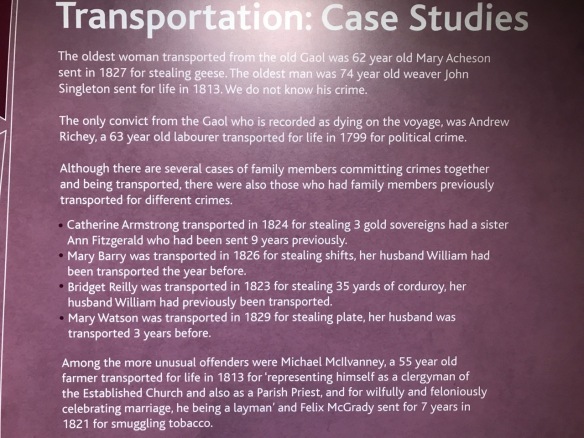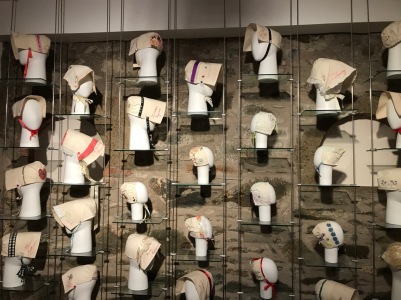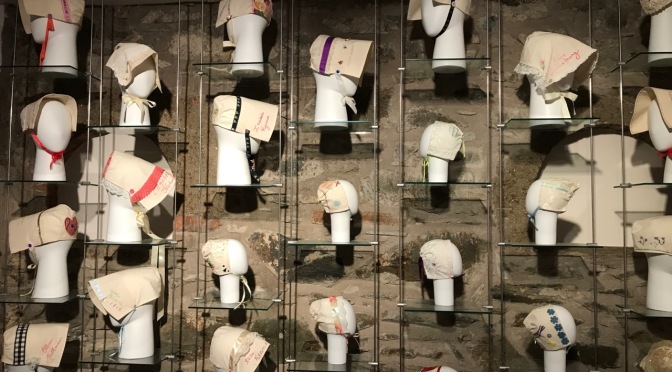Today’s post comes from Jacque.
The trip to Ireland is a week and a half behind me now, which allows the fog to clear as routine life, my real life, resumes. As I reflect on the trip the highlights are emerging from the distance of time and place. One of the highlights is the County Down Museum for which there was no admission fee, a small facility located in the building that lodged the county gaol and gallows during the 19th Century. Two wings of it display artifacts of the area reaching back to pre-Christian times.

The part that interested me, though, was the exhibit about the gaol, especially the display about the women, arrested for “crimes,” then sentenced to life in Australia. I have included the pictures of the narratives, telling of the women, children, and families transported for crimes. You will see that their crimes were crimes of poverty and survival, often preceded by the husbands and fathers of a family being arrested and sent off to Australia. That left a desperate family with no financial support.


Down a narrow hall from the main exhibits was a reproduced gaol cell holding women and children, including the one pallet to be used as a bed and shared by all in the cell. It was cold and dank and surely cleaner than the ones used 200 years ago. I looked at it and shuddered. I have seen exhibits similar to this before. What made this one so meaningful to me, what set this apart significantly, was the display of nineteenth century bonnets re-created in the styles of the time.


The arrays of bonnets, embellished and decorated with scraps of fabric, embroidered hearts, lace, and ribbons were so lovely. Representing these women without being creepy, I found the bonnets to be the perfect symbol of the lives of these women. The beauty of this has stayed with me. I keep returning to the picture of the bonnets to show others, to look at and study, to savor. I find it a pleasing, perfect memory. Ideal.
What ideal symbol have you encountered?


I have another answer for your question, Renee, but first I’d like to comment on bonnets. Bonnets have not been part of my experience. I’m not sure I’ve ever seen an actual bonnet . . . just images of them. And yet I have a sense of what they represented.
A woman I got to know in my “Match-dot-com” years was raised in a fundamentalist religion. She explained that a woman’s hair was considered to be her “crowning glory,” a bit of beauty that a woman should only share with her husband. That necessitated wearing a bonnet, scarf or hat at all times in public. A major function of a bonnet, in other words, was to attest to her modesty (in much the way Muslim women wear a hijab). So a bonnet was a statement about a woman’s conformity about revealing her beauty.
That makes the bonnets you describe interesting. The bonnets themselves seem to say “I’m a good woman and certainly no floozy.” But the hearts, ribbons and lace seem to also say “I am myself, not just anyone, and I care about beauty.”
LikeLiked by 2 people
Rise and Tie Your Bonnet Baboons,
I am just so glad that bonnets are now out of style and I do not have to wear one very minute of my day.
LikeLiked by 2 people
It must be my topurn to be ABD
LikeLike
I am reminded of the recurrence of Laura’s chastisement by Ma for bonnet non-conformity.
I first encountered the “Laura” books in the early 70s, when non-conformity seemed to me to be the way of things, so this seemed a perfectly fine thing for the young heroine in a children’s book to be doing.
I wonder how it was perceived at the time of the writing of the books, and I really wonder how it was perceived at the time.
I do recall her saying something about how much she hated not being able to see the entire horizon because of the bonnet. I know the rationale was to keep a woman’s complexion as pale as possible, and surely it made it harder to see a woman’s face. But I wonder how much it also served to make it impossible for a woman to look at something without everyone being able to know where she was looking.
I’m not generally overtly rebellious about society (personally, yes, yes I am), but lately, I am feeling extremely fed up with “the way things are”.
LikeLiked by 4 people
The COEXIST bumper sticker. It’s all symbols.
LikeLiked by 4 people
Lovely post, Jacque. Our friend W whom we just moved has all kinds of symbolic fused glass pieces he has created… geometric designs arranged just so. I’ll have to ask him, when the dust settles, to let me in on the esoteric symbolism.
Still thinking…
LikeLike
Great post, Jacque. Unfortunately I’ve got nothing in regards to your question. I’m babysitting this afternoon which involves sitting in the sunshine in my backyard while the twins industriously work in the sandbox. Makes me feel very lazy.
LikeLiked by 3 people
Sand tray therapists have hundreds of figures and representatve objects for people to use to create sand tray scenes. I think they theorize that there are some universal meanings for some objects, but that we create our own meanings. It is pretty Jungian.
LikeLiked by 1 person
The twins are all about imaginative play using their many trucks and machines. I just leave them to it unless one of them is getting hurt.
LikeLike
Wow, where’s the rest of baboondom today?
I consider the Bicycle to be a symbol of independence, to a point. It’s our second car, I love the wind on my face and the perfect pace – slow enough to notice details of the world I’m traveling in, fast enough that it isn’t boring. It also seems to surprise people that an old gal is on a bike – so it seems to also be a symbol of youth.
LikeLike
It must be something I said?
LikeLike
Oh, no! It was a lovely post!
LikeLike
I was really just kidding around when I wrote that. So far it has been a slow week, and you cannot take that personally.
LikeLiked by 1 person
One baboon was super busy today! And I can’t really think of a good answer either!!
LikeLiked by 1 person
What vs said. This is my first foray into baboondom all day and my fried brain can’t process a response. It has nothing to do with the quality of the post. Carry on.
LikeLiked by 2 people
Current life is complicated and draining. We have quality here, but life gets in the way.
LikeLike
Lovely post, Jacque. Just can’t think of an answer.
Although I was an English major, and consequnetly well acquainted with symbols, metaphors, and such, I tend to be a rather literal person. I don’t think much in terms of symbols; at least not on a conscious level.
I do recall at a very difficult juncture in my current marriage, breaking a ceramic bowl made by the potter husband of a dear friend. I loved that bowl, and although I had lots of other pots thrown by Ken, that bowl had been a wedding gift from the two of them, and so I had attributed to it a symbolic value that none of his other pots held. When it was broken, it was not beyond repair, but it seemed to represent to me the fact that my marriage had also been damaged, and at the time, I was not sure whether it was repairable.
LikeLiked by 3 people
Wish I had something, but I’m too literal to see symbols when I come across them.
Lovely post, though!
LikeLiked by 2 people